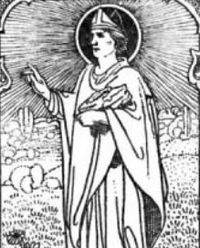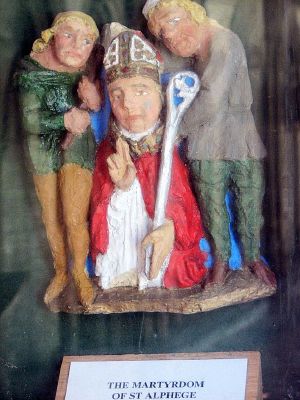Saint Aelfheah
| Alphage (Born: Ælfheah) | |
|---|---|
Alphege in The Little Lives of the Saints, illustrated by Charles Robinson in 1904. | |
| Martyr | |
| Born | 954 |
| Died | April 19, 1012 (martyred) |
| Venerated in | Roman Catholicism; Anglican Communion |
| Canonized | 1078 |
| Feast | 19 April |
| Attributes | Archbishop holding an axe |
| Patronage | Greenwich; Solihull; kidnap victims |
Saint Alphege is the Latinate name of Ælfheah (954–19 April, 1012), the Anglo-Saxon Bishop of Winchester and, later, Archbishop of Canterbury.
Life
Alphege was born in Weston in Somerset, of a noble family, but in early life gave up everything to devote himself to his faith. Having assumed the monastic habit in the monastery of Deerhurst, he passed thence to Bath, where he became an anchorite and ultimately abbot of the abbey there, distinguishing himself by his piety and the austerity of his life.[1] In 984, he was appointed, through Dunstan's influence, to the Bishopric of Winchester[2] and, in 1006, he succeeded Aelfric as Archbishop of Canterbury.[3][4]
At the sack of Canterbury by the Danes in 1011, Alphege was captured and kept in prison for seven months. Refusing to allow a ransom to be paid, he was murdered at Greenwich, Kent (now London), reputedly on the site of St Alfege's Church there, on April 19th, 1012.[4][3]
An account of his death appears in The Anglo-Saxon Chronicle:
- For there was wine brought them from the south. Then took they the bishop . . . on the eve of the Sunday after Easter . . . They overwhelmed him with bones and horns of oxen; and one of them smote him with an axe-iron on the head; so that he sunk downwards with the blow; and his holy blood fell on the earth, whilst his sacred soul was sent to the realm of God.
Some sources record the final blow, with the back of an axe, being dealt by one Thrum as an act of kindness by a Christian convert.
Death and Veneration
He was buried in St Paul's Cathedral, whence his body was removed by King Canute to Canterbury, with all the ceremony of a great act of state, in 1023.
Alphege was canonised in 1078. An incised paving slab to the north of the present High Altar of Canterbury Cathedral marks the place where the medieval shrine is believed to have stood.
His feast day is 19 April.
Church dedications include: St Alphege the Martyr in Canterbury (now used as an urban studies centre), St Alfege's Church, Greenwich, the twin churches of St Alphege Whitstable and St Alphege Seasalter (chancel only surviving) and St Alphege in Solihull, the main town of the Metropolitan Borough of Solihull. There is also an unexpectedly charming 1930s Catholic church of St Alphege, closely modelled on a Roman basilica, at Oldfield Park, Bath.
There is also an altar dedicated to St Alphege in Bath Abbey with a fine modern frontal designed by Jane Lemon
Biographical Records
Lives of St. Alphege in prose—which survives—and in verse were written by command of Lanfranc by the Canterbury monk, Osborn (died ca. 1090), who says that his account of the solemn translation to Canterbury in 1023 was received from the dean, Godric, one of Alphege's own scholars.
Notes
External links
- Early British Kingdoms: St. Aelfheah of Canterbury
- The Martyrdom of Ælfheah, from the Anglo-Saxon Chronicle
- Saint Alphage in The Golden Legend
- Prosopography of Anglo Saxon England: Ælfheah
ReferencesISBN links support NWE through referral fees
- This article incorporates text from the Encyclopædia Britannica Eleventh Edition, a publication now in the public domain.
- Baring-Gould, S. (Sabine). The Lives of the Saints. With introduction and additional Lives of English martyrs, Cornish, Scottish, and Welsh saints, and a full index to the entire work. Volume I. Edinburgh : J. Grant, 1914.
- Butler, Alban. Lives of the Saints. Edited, revised, and supplemented by Herbert Thurston and Donald Attwater. Palm Publishers, 1956. The original version is accessible online at: the Global Catholic Network.
- Farmer, David Hugh. The Oxford Dictionary of Saints. Oxford; New York: Oxford University Press, 1997. ISBN 0192800582.
- Knowles, David; Brooke C. N. L.; and London, Vera C. M. The Heads of Religious Houses: England and Wales (940-1216). Cambridge: Cambridge University Press, 1972. ISBN 0-521-08367-2.
- Powicke, F. Maurice and E. B. Fryde. Handbook of British Chronology (2nd edition). London: Royal Historical Society, 1961.
- Ryan, Patrick. "Saint Elphege" in The Catholic Encyclopedia. 1909.
- Walsh, Michael. A New Dictionary of Saints: East and West. London: Burns & Oats, 2007. ISBN 0-8601-2438-X.
| Religious titles | ||
|---|---|---|
| Preceded by: Æthelwold |
Bishop of Winchester 984–1006 |
Succeeded by: Cenwulf of Winchester |
| Preceded by: Ælfric of Abingdon |
Archbishop of Canterbury 1006–1012 |
Succeeded by: Lyfing |
| List of Archbishops of Canterbury | |
|---|---|
| Pre-Reformation Augustine · Laurentius · Mellitus · Justus · Honorius · Deusdedit · Wighard · Adrian · Theodore · Bertwald · Tatwin · Nothelm · Cuthbert · Bregwin · Jaenbert · Æthelhard · Wulfred · Syred · Feologild · Ceolnoth · Ethelred · Plegmund · Athelm · Wulfhelm · Oda · Aelfsige · Birthelm · Dunstan · Æthelgar · Sigeric · Ælfric · Alphege · Lyfing · Aethelnoth · Edsige · Robert of Jumièges · Stigand Lanfranc · Anselm · Ralph d'Escures · William de Corbeil · Theobald · Thomas Becket · Richard · Baldwin · Reginald Fitz-Jocelin · Hubert Walter · John de Gray · Stephen Langton · Walter d'Eynsham · Richard le Grant · Ralph Neville · John of Sittingbourne · John Blund · Edmund Rich · Boniface · William Chillenden · Robert Kilwardby · Robert Burnell · John Peckham · Robert Winchelsey · Thomas Cobham · Walter Reynolds · Simon Mepeham · John de Stratford · John de Ufford · Thomas Bradwardine · Simon Islip · William Edington · Simon Langham · William Whittlesey · Simon Sudbury · William Courtenay · Thomas Arundel · Roger Walden · Thomas Arundel · Henry Chichele · John Stafford · John Kemp · Thomas Bourchier · John Morton · Thomas Langton · Henry Deane · William Warham · Thomas Cranmer · Reginald Pole Post-Reformation |
| Persondata | |
|---|---|
| NAME | Alphege |
| ALTERNATIVE NAMES | Ælfheah |
| SHORT DESCRIPTION | Bishop of Winchester, Archbishop of Canterbury, Saint |
| DATE OF BIRTH | 954 |
| PLACE OF BIRTH | |
| DATE OF DEATH | April 19, 1012 |
| PLACE OF DEATH | Greenwitch, Kent |
Credits
New World Encyclopedia writers and editors rewrote and completed the Wikipedia article in accordance with New World Encyclopedia standards. This article abides by terms of the Creative Commons CC-by-sa 3.0 License (CC-by-sa), which may be used and disseminated with proper attribution. Credit is due under the terms of this license that can reference both the New World Encyclopedia contributors and the selfless volunteer contributors of the Wikimedia Foundation. To cite this article click here for a list of acceptable citing formats.The history of earlier contributions by wikipedians is accessible to researchers here:
The history of this article since it was imported to New World Encyclopedia:
Note: Some restrictions may apply to use of individual images which are separately licensed.

